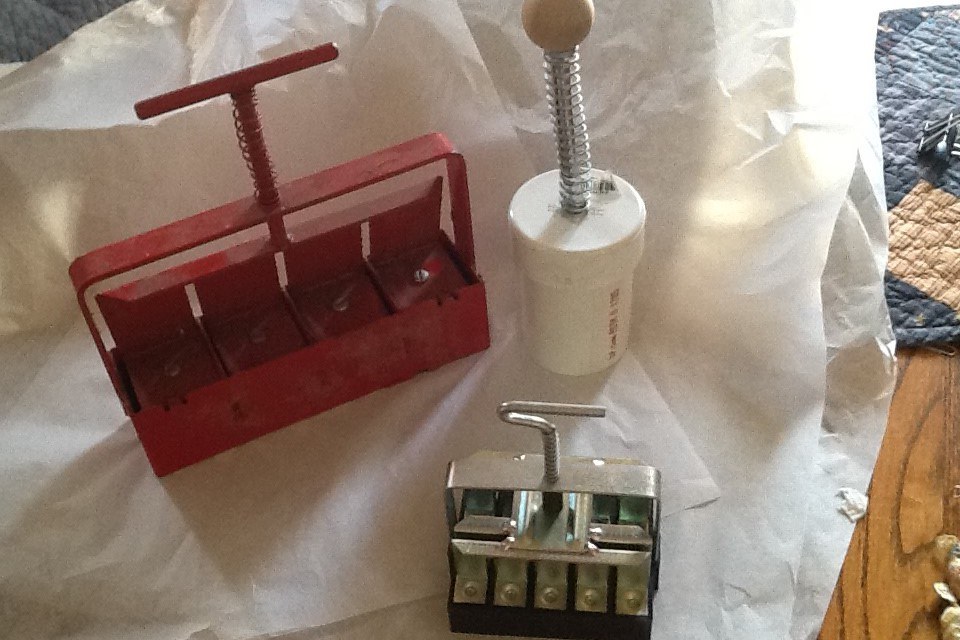Soil blocks are basically molded soil in a single block. These blocks serve as the container and growing media all in one. Eliminating the need for those pesky plastic 6 pack trays that seem to take over my shed!

Various Soil Blockers - (top right is homemade)
Well, it's that time of year to think about starting seedlings for the garden. You have many choices as to what containers you start them. You can use plastic seed trays; cow or peat pots; winter sowing, etc. I use soil blocks, they are easy and quick to make.
Commercially available blockers range in size for 3/4", 2" and 4". You are able to purchase inserts which allow the 3/4" blocks to nest in the 2" block and the 2" block to nest into the 4" block. Thus you can start small seeds in the 3/4" blocks, as soon as they emerge they can be placed into the 2" block. The 2" block is good for most all seeds. The 3/4" is good for small seeds such as celery, parsley, peppers, eggplant can be started in 3/4" blocks, but should be transplanted in the 2" blocks as soon as the plant emerges.
Seedlings that are grown in soil blocks establish stronger root systems than those grown in containers. This is due to the increased oxygen to the roots and the soil block's natural tendency to "prune" roots. The soil block creates an advantage when transplanting in the garden. The plant establishes itself more quickly, since there is less root disruption, they are less prone to transplant shock. This is due to the increased root surface area and the air pruning of the roots.
The roots will grow until they reach the edge of the soil blocks. They will stay there ready and willing to reach out to and grow once they are placed in soil. As opposed to plants in containers which will become root bound.
The key to success with soil blocks is using a mix of peat, compost, soil, and sand or Perlite. The most important ingredient to this mixture is the peat - Its Fibrous consistency is used to both bind the material together and help retain moisture. You can either mix your own mixture or you can buy a pre made mix for soil blocks. I have done both. There are a number of block mixtures on the market - Johnny's Seed makes a mixture 512 mix, which I have used in the past. One thing to consider- you cannot use traditional potting soil for soil blocks- It is not the right consistency. A blocking mixture needs the peat to bind everything together and retain moisture.
Here is the basic formula for mixing your own soil block mixture:
| Makes 2 Bushels | Ingredients | Makes 1 Bushel | Makes 1/2 Bushel |
|---|---|---|---|
| 30 qt | Peat Moss | 15 qt | 7.5 qt |
| 1/2 cup | Lime | 1/4 cup | 1/8 cup |
| 20 qt | Perlite | 10 qt | 5 qt |
| 1 cup | Blood Meal | 1/2 cup | 1/4 cup |
| 1 cup | Colloidal Phosphate | 1/2 cup | 1/4 cup |
| 1 cup | Green Sand | 1/2 cup | 1/4 cup |
| 10 qt | Compost | 5 qt | 2.5 qt |
| 20 qt | Garden Soil | 10 qt | 5 qt |
This recipe is based upon Elliot Coleman's Formulation in his book "The New Organic Grower" and Johnny's Seeds.
Mix thoroughly together in large tub, you may want to use a sifter screen to screen out some larger debris in the peat and compost. In a separate tub, (Pull out roughly enough dry material to make as many soil blocks as you will need), mix 3 parts mix to 1 part warm water. It should be the consistency of concrete or putty mix - Not real soupy and not real dry. Place the blocks about 1/4" apart in a seedling tray or waterproof tray.
Once you plant your seeds you will probably not need to water, if planted in freshly made blocks, for probably two to three days. When watering, you should use a fine mist to water the blocks. Water the block from the bottom up. Do not use a large or course water flow as it will erode the block. I use a misting bottle.
To get started - you can either purchase a soil block maker or make one yourself - here are a few sources (feel free to search other options):
Or if you are handy you can make variations of them, here are some ideas:
By Master Gardener Jim Kasten

